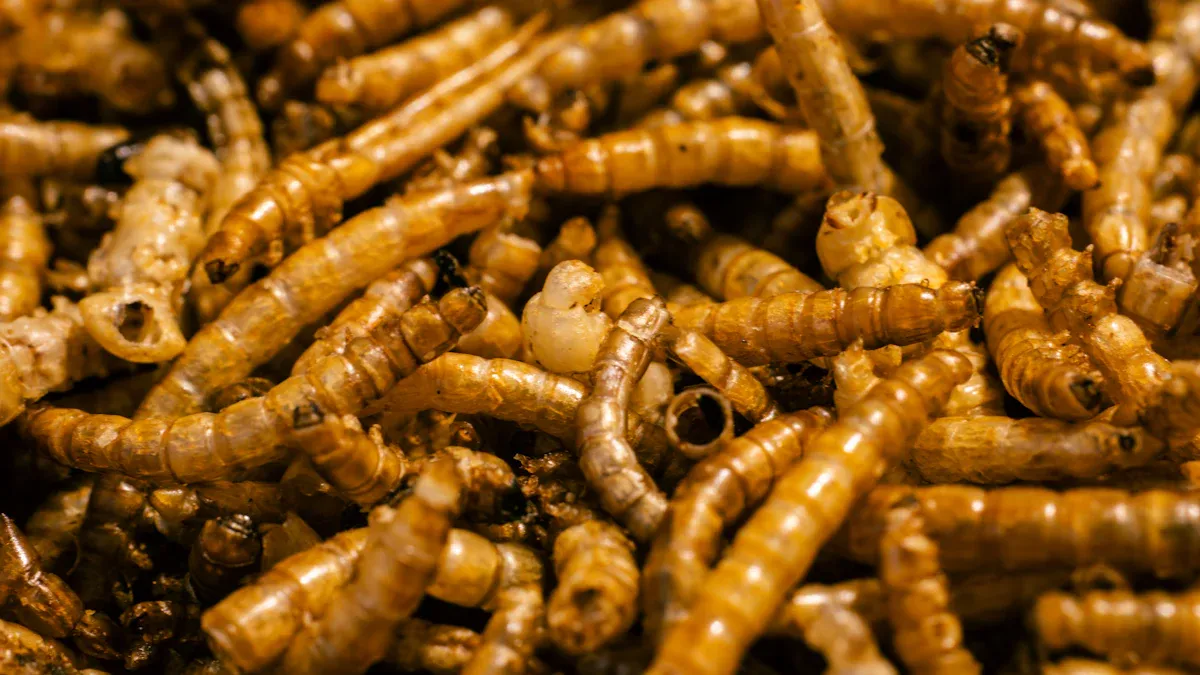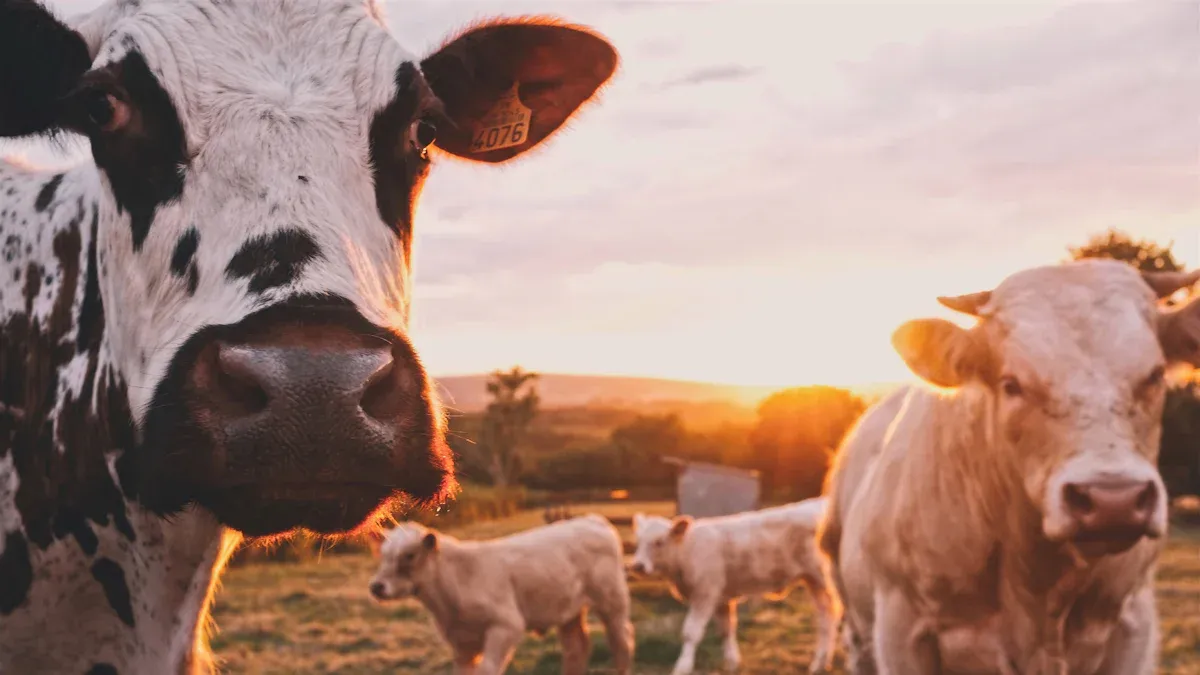
Have you ever wondered how to boost your livestock’s health and productivity? Dried mealworm for livestock might be the answer. Packed with 51.93% protein, mealworms outperform traditional feeds like soybean meal. Studies show they improve feed conversion rates and growth performance, making them a sustainable, cost-effective choice for farms in Spain.
Key Takeaways
- Dried mealworms have 51.93% protein, more than soybean feed.
- Adding mealworms to animal diets helps them grow faster. It also improves meat quality and uses feed better, saving farmers money.
- Mealworms are good for the environment. They need fewer resources to grow and help make farming more sustainable.
Nutritional Benefits of Dried Mealworm for Livestock
High Protein Content for Livestock Growth
Protein is the building block of growth, and dried mealworm for livestock delivers it in abundance. With a protein content of 51.93%, mealworms outshine traditional feed options like soybeans, which only offer 44.51%. This high protein level supports faster growth and better muscle development in livestock.
Mealworms also boast crude protein levels ranging from 47% to 60%, making them a powerhouse of nutrition. Their lipid content, which falls between 31% and 43%, provides an additional energy boost. These qualities make mealworms an excellent choice for farmers looking to enhance their livestock’s growth and overall health.
Here’s a quick comparison of protein content in different feed options:
| Feed Option | Protein Content (%) |
|---|---|
| Dried Mealworms | 51.93 |
| Soybeans | 44.51 |
| Maggots | N/A |
| Silkworms | N/A |
Essential Nutrients for Health and Productivity
Dried mealworm for livestock isn’t just about protein. It’s packed with essential nutrients that keep your animals healthy and productive. Mealworms contain nitrogen-free extracts (2.8% to 3.4%) and lipids (14.9% to 43.1%), which are vital for energy and overall well-being. These nutrients improve feed efficiency and ensure your livestock gets the most out of every meal.
Studies have shown that mealworms enhance meat quality and boost immunity in animals. By including them in your livestock’s diet, you’re not just feeding them—you’re fortifying their health.
Positive Effects on Livestock Performance
When you feed your livestock dried mealworms, you’ll notice a difference in their performance. Animals grow faster, produce higher-quality meat, and show improved feed conversion rates. This means they require less feed to gain weight, saving you money in the long run.
Farmers who’ve switched to mealworms report healthier animals with shinier coats and better energy levels. It’s a win-win for both you and your livestock.
Practical Applications of Dried Mealworm for Livestock
Feeding Methods for Different Livestock
You might wonder how to feed dried mealworm to your livestock. The good news? It’s versatile! For poultry, you can mix mealworms with their regular feed or scatter them on the ground to encourage natural foraging. Cattle and pigs benefit from mealworms when they’re blended into their grain-based diets. Even fish thrive on mealworms, either as a standalone feed or mixed with pellets.
Tipp: Start small and observe how your animals respond. Adjust the feeding method based on their preferences and behavior.
Recommended Quantities and Feeding Schedules
Feeding the right amount is key to getting the best results. For poultry, aim for 5-10% of their daily feed to be dried mealworm. Cattle and pigs can handle up to 15% of their diet as mealworms. Fish require smaller amounts, around 2-5% of their feed.
Stick to a consistent schedule. Feed your livestock twice a day, once in the morning and again in the evening. This routine helps them digest the mealworms effectively and ensures they get a balanced diet.
Steps for Introducing Mealworms into Diets
Switching to dried mealworm for livestock is simple. Start by mixing a small amount—about 2% of their total feed—into their regular diet. Gradually increase the proportion over two weeks. This slow introduction helps your animals adjust to the new feed without digestive issues.
Keep an eye on their health and performance. If you notice positive changes, like better energy or shinier coats, you’re on the right track!
Economic and Environmental Benefits of Dried Mealworm for Livestock

Cost-Effectiveness Compared to Traditional Feeds
Feeding your livestock doesn’t have to break the bank. Dried mealworm for livestock offers a cost-effective alternative to traditional feeds like soybeans or fishmeal. Mealworms pack more nutrients per gram, so you can use less feed while still meeting your animals’ dietary needs. This means you save money without compromising on quality.
Farmers who’ve made the switch often report lower overall feed costs. Why? Because mealworms improve feed efficiency. Your livestock grows faster and healthier, which reduces the time and resources needed to raise them. It’s a smart investment that pays off in the long run.
Sustainability and Reduced Environmental Impact
If you care about the planet, mealworms are a fantastic choice. They require fewer resources to produce compared to crops like soybeans. Mealworms need less water, land, and energy, making them an eco-friendly option. Plus, they produce significantly lower greenhouse gas emissions.
By choosing mealworms, you’re not just feeding your animals—you’re helping the environment. Every small change counts, and this one has a big impact.
Lower Dependence on Resource-Intensive Feeds
Traditional feeds often rely on resource-heavy farming practices. Soybeans, for example, contribute to deforestation and soil degradation. Switching to mealworms reduces your dependence on these unsustainable options.
Mealworms are easy to farm and reproduce quickly. This makes them a renewable and reliable feed source. By incorporating them into your livestock’s diet, you’re supporting a more sustainable future for farming.
Suitability of Dried Mealworm for Spanish Farms
Adaptability to Spain’s Climate and Farming Practices
Spain’s climate is ideal for incorporating dried mealworms into your farming practices. Mealworms thrive in warm, dry conditions, which align perfectly with Spain’s Mediterranean climate. This makes them a reliable and consistent feed source for your livestock. Whether you’re raising poultry, cattle, or fish, mealworms adapt well to various farming systems.
You’ll also find that mealworms integrate seamlessly into Spain’s traditional and modern farming methods. If you’re running a small family farm or a large-scale operation, mealworms can fit into your feeding routines without much hassle. Their versatility ensures they work for you, no matter your setup.
Local Availability and Market Trends
The demand for dried mealworm for livestock is growing rapidly in Spain. You’ll notice more suppliers offering mealworms as farmers recognize their benefits. This increasing availability means you can source them locally, reducing transportation costs and ensuring freshness.
Market trends also show a shift toward sustainable and high-nutrition feeds. Mealworms are leading this movement. By adopting them now, you’re staying ahead of the curve and positioning your farm as a forward-thinking operation.
Regulatory Guidelines for Feed Use in Spain
When introducing mealworms to your livestock’s diet, it’s essential to follow Spain’s feed regulations. The European Union has approved mealworms as a safe and sustainable feed option. However, you should always check for updates on local guidelines to ensure compliance.
You’ll also want to source mealworms from certified suppliers. This guarantees quality and ensures the feed meets all safety standards. By following these steps, you can confidently use mealworms while adhering to Spain’s regulations.
Dried mealworms are a game-changer for livestock nutrition. They provide high protein, essential nutrients, and sustainability benefits that traditional feeds can’t match.
Why wait? By switching to mealworms, you’ll boost your livestock’s health, productivity, and profitability. It’s a smart, eco-friendly choice that supports your farm’s success. Start small, observe the results, and watch your animals thrive!
FAQ
What types of livestock benefit most from dried mealworms?
Poultry, cattle, pigs, and fish thrive on dried mealworms. Their high protein and nutrient content make them suitable for a wide range of animals.
How do I store dried mealworms to keep them fresh?
Store them in a cool, dry place in an airtight container. This prevents moisture and pests from spoiling the feed.
Tipp: Refrigeration extends their shelf life even further!
Are dried mealworms safe for all livestock?
Yes, they’re safe when sourced from certified suppliers. Always introduce them gradually into your livestock’s diet to ensure proper digestion and adaptation.


